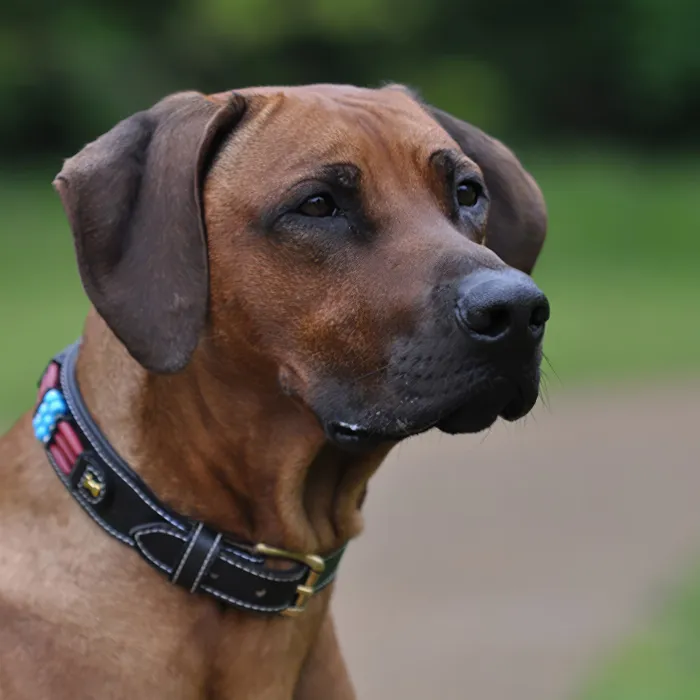Part 01 - Introduction: Animal motif - beastly good!
Part 02 - The right equipment
Part 03 - The main problems: light & sharpness
Part 04 - It's all about the detail!
Part 05 - Shooting preparations and planning
Part 06 - Dog photography
Part 07 - Cat photography
Part 08 - Horse photography
Part 09 - Small animal photography
Part 10 - Indoor shoots - studio photography
Part 11 - Outdoor shootings
Part 12 - Image editing
Part 13 - Various general tips
Part 14 - Reptile photography
There are a number of subsections to this rather detailed tutorial, here is a brief overview:
- Introduction
- Fear of dogs
- The position of the photographer
- Preparation of the shoot
- Preparation of the model
- Germanys next Topmodel - Allow your star to rest and recuperate
- The dog and his pack
- Bello in action: the dog outdoors
-The right light/sun position
-Outdoor shoot with a concept
-Bello in the forest
-Bello jumping
-Bello in the water
-Bello running
-Bello playing
-Bello's characteristics on the picture
-Bello's creative search
-Bello doing dog sports - The dog in the studio - instructions for the dog owner
-The educational level of the dog
-Picture details
-General information
Bello has a lot to show, so let's not keep him waiting ...
1. introduction
Every photographer will have their own special favorites. The animal photographer will also have a breed or species that he particularly likes to have in front of his lens. If you had asked me before I started working, I could have clearly listed my favorites and what I would like to photograph in the course of my later work and what I would not like to photograph at all. But if you asked me today, I would tell you: I love photogenic models and unphotogenic ones are the challenge I am looking for in my work. And that has nothing at all to do with the appearance of the subject, which I would have always assumed in the past. Since we're talking about dogs here, I would have told you in the past: "I love photographing bullies and Great Danes. Yes, and I really have to get a Rhodesian Ridgeback in front of my lens. I'm terrified of fighting dogs and I'll certainly never enjoy photographing sheepdogs..." How quickly this opinion, which couldn't have been more intolerant, changed. Today, my wish list looks completely different. In the past, for example, I never thought about where I would like to see my models, the focus was always on the model itself. Today it's completely different, ask me again today. Here's my answer: "Let's see how it turns out, I'm looking forward to it!" - If you tell me which animal I can photograph, I immediately have an idea of how I can best photograph the four-legged friend! And then a whole backdrop clearly emerges in my mind, landscapes with meadows and woods, background colors for the studio wall, I immediately have in mind how I would like to photograph this animal. If I could choose for myself, I would take completely different models today. But I have to see the dog, let it have an effect on me in front of the camera and then it doesn't matter whether it's a long-haired dachshund or a bull terrier. I've learned that in the course of my work. Dogs will seduce people with their charm in such a way that appearance, size and breed are suddenly completely irrelevant. All that counts is the lovable character. And that's what photographers have to capture on paper.
Let me give you an example: My partner was with me on a day shoot with dogs. He loves dogs more than anything, but doesn't like Dalmatians and is terrified of bull terriers. No sooner said than done. Of course, a young woman came to the shoot in the afternoon with three dogs. You can guess, right! A Dalmatian and a bull terrier were in her luggage. I couldn't help but tell the lady during the shoot, because after a certain amount of time getting to know her, my partner lay on the floor with the bull terrier lady Lola and scratched her belly while the little Dalmatian gave him paws and kisses at the same time. When the young lady and her dogs said goodbye to us, she told me to say hello to the man who doesn't like Dalmatians and bull terriers. He still raves about these two dogs today and I know he would have taken them home with him immediately. It's exactly the same in front of the lens. You'll soon find this out if you photograph not only your own dogs, but other people's dogs. Suddenly, you will find a dog that you used to think was "boring" or "not my type" interesting and perhaps even lovable.
As soon as I receive a shooting assignment, I usually ask for the dog breed so that I have a picture in mind. Meanwhile, I'm looking for models who aren't really my type of dog, but I'd love to photograph them. I bet that they would seduce me with their charm during the shoot and wrap me around their little finger. At the end of the shoot, I would certainly take these dogs home with me without hesitation and very happily!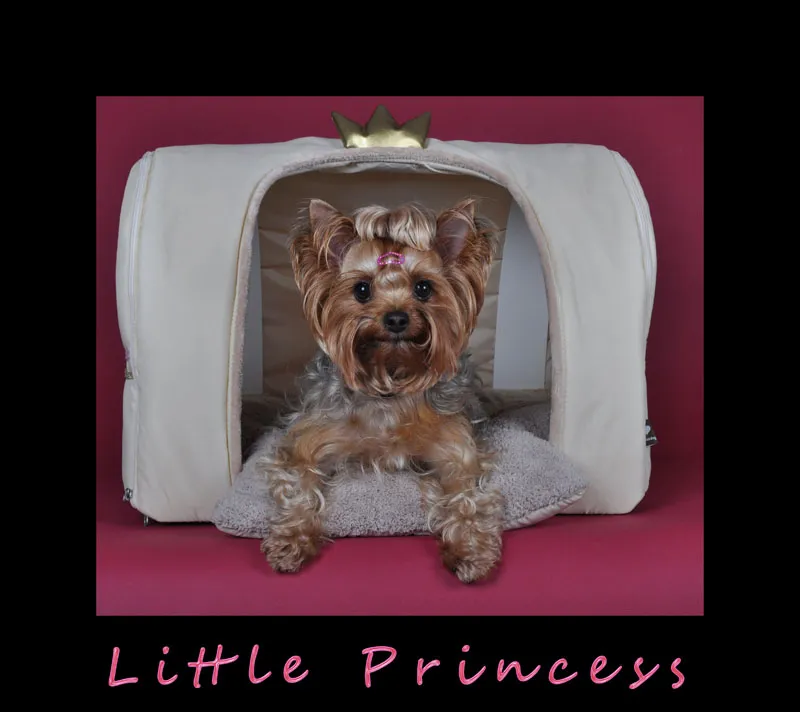
Yorkshire Terriers, for example, have never been one of my favorite dogs, but this little mouse named Thea immediately fascinated me. She was incredibly sweet and trusting and gave us free rein during the shoot. However, she was 100% focused on her owner!
2. fear of dogs
I have a very special bond with dogs. When I started my hobby of animal photography, I was unsure whether I would ever be able to photograph dogs. I was very afraid of dogs, as I had been growled at and attacked several times. From a West Highland Terrier that bit a chunk out of my leg to a Rottweiler that once snapped at my face (a small threat, that's all it was) to sheepdogs that chased me around the riding school when I was a young girl. They kept me in a horse stall for hours, snarling and barking, until someone came to my rescue. My fear had grown over the years and at some point I could no longer look at a dog without becoming terrified. Even the most peaceful dogs would start to bark or become restless. They sensed it, always! Even before I did. And that always provoked even more unpleasant situations. If you are invited somewhere and know that a dog lives there that you don't know, this can quickly cause you to break out in a sweat if you have a dog phobia. To cut a long story short: the dogs have also freed me from this fear again, because since I have been photographing dogs almost every week, I feel much better and my fear has disappeared. There are just too many nice and lovely dogs and I enjoy my work so much that I never wanted to be restricted by it. I am very happy that I can once again interact with other dogs, romp and play with them so freely and without fear. I can approach them with the camera without hesitation. So, take courage! Dogs are wonderful subjects and, thanks to their loving nature, they can also convince people with this fear that not every dog is bad. I also know today that I made a lot of mistakes and that I often behaved wrongly. Dogs are never angry without a reason and a German shepherd will defend his house and land and even a Rottweiler will say, "This is my private area, you have no business here! Otherwise, just read something about these wonderful animals and you will quickly recognize how they behave in certain situations and how you as a human should react to them.
But I can also recommend a few books on this subject to dog owners or even those who are new to dogs:
- Dog - German / German - Dog - Costs approx. 10.00 euros
- Hundeverhalten - Verhalten verstehen, Körperprache deuten - Barbara Schöning - costs approx. 10,00 Euro
- Dog Psychology by Dorit U. Feddersen-Petersen - costs approx. 40.00 euros
- Expressive behavior of the dog by Dorit U. Feddersen-Petersen - costs approx. 40,00 Euro
There are now hundreds of such books, just have a look around!
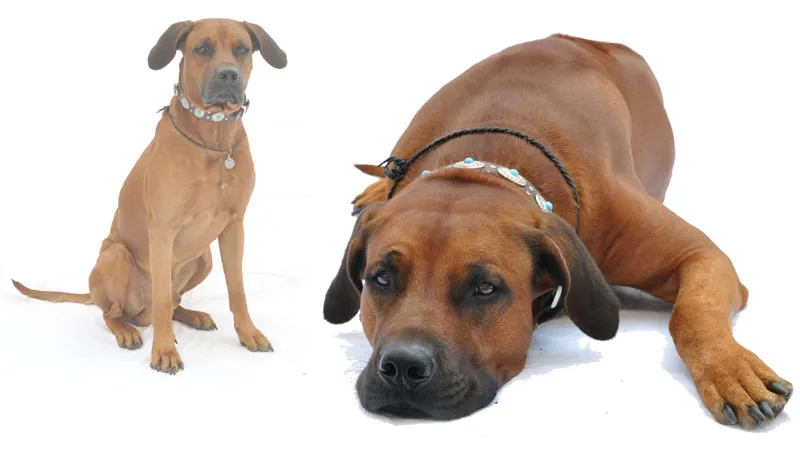
This dog looked terrifying. A Rhodesian Ridgeback with a fighting weight of over 60 kg. On the left he looks scary, on the right he shows his true face!
3. the position of the photographer
Outdoors
For almost all outdoor shots, if possible, I lie on the ground at eye level with the animal. Kneeling or sitting is of course also possible. Of course, this depends on a few factors, including the size and distance of the animal. Well, sometimes it also depends on the condition of the floor! If you want to photograph a standing Great Dane lying down, it can be difficult, but it can also look quite interesting under certain circumstances.
I almost always lie down for studio shots. You should never photograph your subject from above, it looks unprofessional. Of course, there are one or two snapshots where this is exactly the intention. Nevertheless, you should try to be at eye level with the animal. For fun, take pictures from all sides, from above, from eye level and from below. You'll see what I mean ... If you stand the whole time and then suddenly lie down on the ground, one or other dog may react strangely. You should be prepared for this. These two Australian Cattle Dogs, for example, came straight at me. Some dogs just want to play and give you a kiss, others might want something else. Since you are holding high-quality equipment in your hands and are in a very awkward position, especially with large dogs lying down, you should really pay attention to this.

This shot was taken when I had just got down to eye level. As you can see from the photo, the Australian Cattle Dog noticed this at that moment. He then dropped the frisbee and charged towards me, with no good intentions in mind. Fortunately, the owner called the dog back in time.
In the studio
Sometimes I use a table for small dogs. The advantage of this is that they can't run away so quickly and are a bit more fixed. It is best to clarify with the owner beforehand whether this is OK for the dog. If the dog is sitting on a table, I have to bring myself to eye level. I either bend forward or crouch down, sometimes you can also use a chair. However, if I'm working directly on the floor, I have to be there too. This means that if a large dog is in a sit position, I will kneel down. If he is lying down, then I will do the same. I always try to stay at eye level. A sleeping mat can therefore be very useful! As described, you have to play a little with focal lengths and the distance to the animal when taking detailed shots, for example, but be careful, especially if you lie down on the floor like I do. Then it can happen that the dog jumps towards you and not always in a friendly way. Always give the dog his zone, where he feels comfortable and not harassed.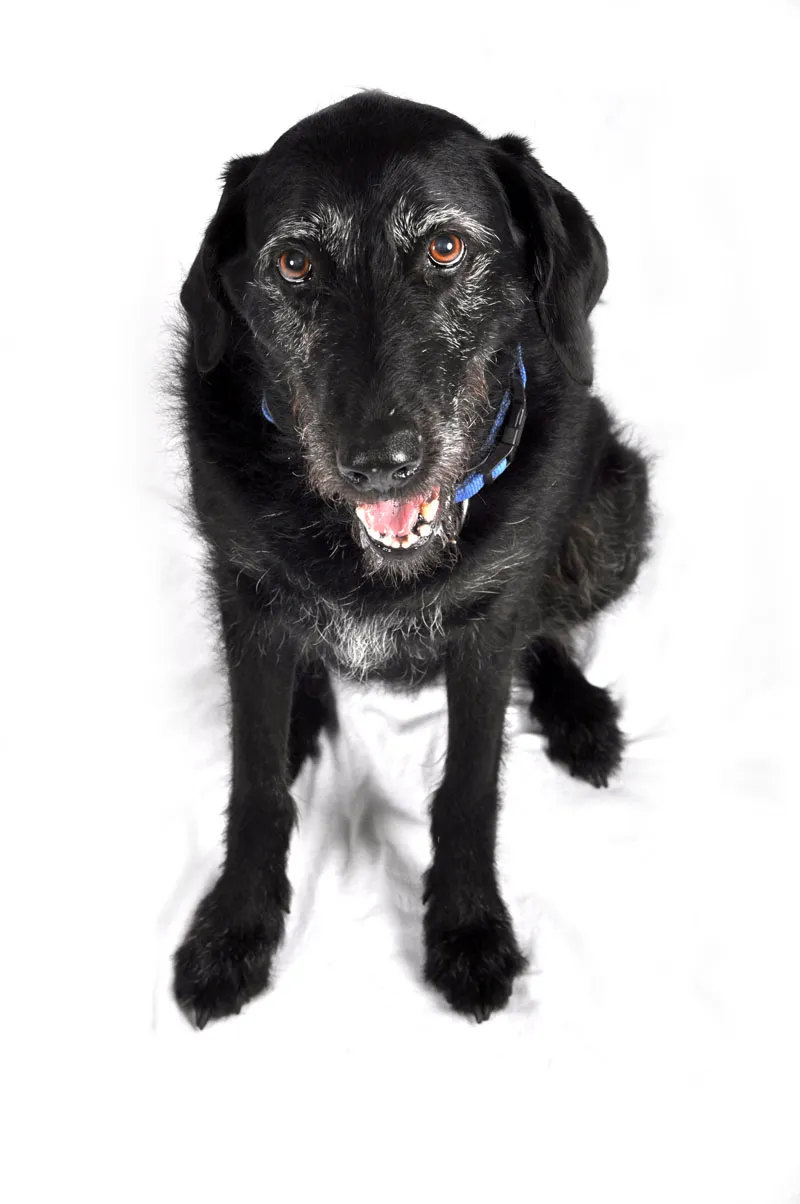
Here, the angle from above was desired.
4. preparation for the shoot
If it is not your own dog, ask which four-legged friend you are allowed to photograph. For your planning, it is of course important whether you are photographing a Westhighland Terrier or a German Shepherd, regardless of whether it is a studio or an outdoor shoot. For studio photography, the color and size of the animal is crucial. You can then choose suitable backgrounds. Also ask about the owner's preferences, as they have to be happy with the photos!
For outdoor shots, simply ask about the dog's preferences and what the two-legged friend thinks are suitable background motifs for their dog. If a dog is passionate about swimming, you already have a great option. Don't hesitate to ask about the dog's age and temperament so that you can make some plans for your shoot in advance. Calm and perhaps somewhat older dogs may not be animated by a flying stick, so it will be difficult to take pictures of them in action-packed motion.
Dog owners often ask me what they should bring with them. This is difficult to generalize. There are dogs that can be animated well with treats, especially in the studio. They fixate on the treats and prick up their ears. They follow the hand holding the treats with their eyes, and this allows you to control the dog well and sometimes even direct their gaze straight to the camera. That's perfect! But there is also the exact opposite. The dog gets fidgety and runs after the hand, it won't sit still and is really obsessed with the treat. Of course, this also depends on the dog's level of training and how well it sticks to what it has been trained to do in a completely new environment with strangers. So, bring treats with you? Yes! But it remains to be seen whether they will really be used sensibly. Well-trained dogs will definitely enjoy the shoot even more if they get a reward for a well-behaved "sit". If possible, you should therefore work with a few delicacies, if only as a thank you to your model. After all, as the photographer, you get a lot of pleasure out of it. Toys are also always good, but more outdoors. Bello's favorite ball is always a good animation to get him moving. In the studio, it's a matter of taste whether you want to include a perhaps not very decorative slobbered bone in the picture. Besides, the dog will chew or bite on it, and that doesn't always look great.
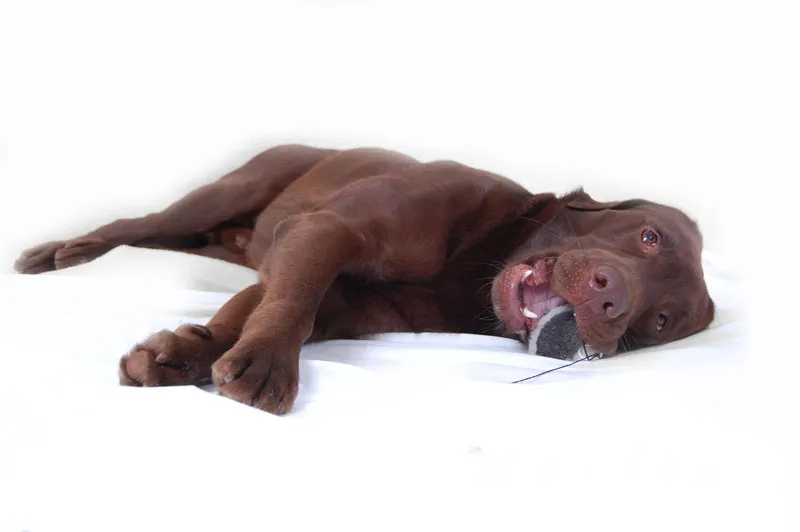
Merlin was totally relaxed chewing on toys, he lay down in the studio and chewed on them with relish.

Of course, you can always add a saying!
5. preparation of the model
Again, this answer cannot always be given clearly for all dogs, but there are a few things you should always bear in mind:
- The dog should not have a meal a few hours before the shoot. It is not good if he moves around a lot on a full stomach (plus the excitement).
- The dog should not go into the shoot exhausted. A puppy that has just come from dog school, for example, will only want one thing: to sleep!
- The dog should not be over-excited during a studio shoot, so a long walk and a bit of romping around before the shoot will help to calm him down.
It's always a fine line, the dog must not be too tired or too active in the studio, for example. If he is fidgeting around, it will be difficult to get him to stay still. However, if he is overtired, he will eventually stop responding to anything and simply sleep. That's nice for 1 or 2 photos, but boring in the long run.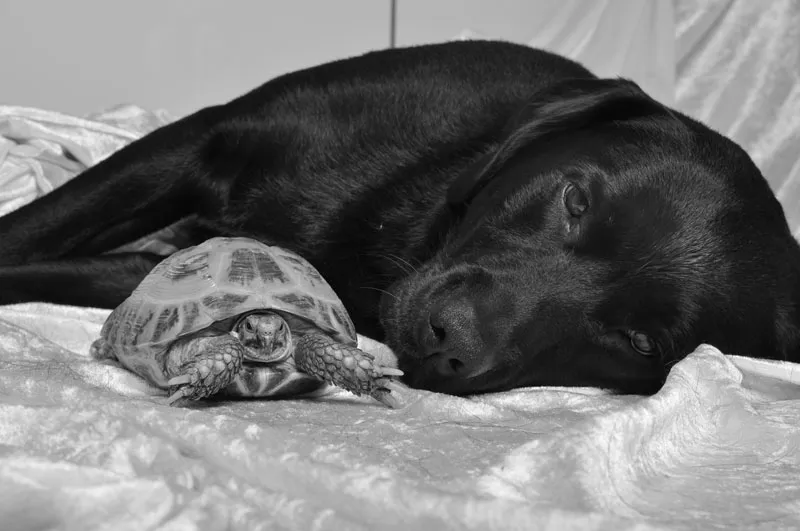
The shoot with Samy was actually already over, we had already dismantled the studio. But the dog was so tired that we covered him with the fabric and placed the turtle next to him. Because it looked so funny, I took out the camera again. We couldn't get him to move any more.
When we take the dog outside, we want him to be as active as possible. Unlike in the studio, it's an advantage if he's lively and excited. If you are doing a combination of both (studio and outdoor shoot), do the outdoor shoot first. But don't overdo it, otherwise you'll end up with a sleeping studio model, as mentioned above. No matter how you do it and how long the shoot lasts, always pay attention to how your four-legged friend is feeling, see also the next point.
6 Germanys next Topmodel - Give your star rest and recuperation
This is an important rule. Because a shoot should never be torture for the animal. The dog must feel comfortable and relaxed. It must not be scared or stressed and, above all, it must be left alone when it needs a break. Provide fresh water and offer it again and again. During the studio shoot, you should always take petting breaks or let the animal do what it wants for five minutes in peace. It's enough not to constantly want something. "Bello, sit!", "Bello, sit!", "Bello come here", "Bello, stay". The commands during a shoot are often too much for the dog and sometimes contradictory. So it often happens that we say "Bello, sit." - The dog goes into a down position. Then follows a "Bello, look." The dog goes into a guarding position and pricks up his ears. We take a photo. "Bello, fine, look here." Bello leaves his seat and comes running up wagging his tail. "No, Bello, sit!". If this goes on for a few minutes, the dog is totally annoyed and no longer wants to obey any commands. If it's not you, simply explain to the dog owner how the shooting affects the dog and ask him to be as patient as you have to be. Entertaining and animating the animal is much more difficult than your part, so take comfort!
If the dogs don't know any commands or if you have suddenly forgotten them in a flurry of flashbulbs, then it can happen that the two-legged friend desperately tries to get the dog to keep still. After all, you want to take such nice photos of Bello. But Bello doesn't know why he suddenly has to keep still, as he never has to. So he doesn't understand why he's suddenly being scolded or why a command is being demanded more forcefully than usual. The result: a scolding mistress, an annoyed photographer and a sad-looking dog. You can answer the question of whether the photos look good yourself!

Samy looks questioningly at his owner because he doesn't know why she's suddenly scolding him.
7 The dog and his pack
I don't have a dog myself, and whenever I have a shoot with dogs, I always envy their owners for the wonderful thing of being able to call such a fantastic animal their own. Dogs love their pack, their humans, they would do anything for them. Their eyes are constantly on their beloved two-legged friend. What should I do? What should I do? What do you want from me? Come on, keep yourself busy with me! The dog fixates on its owner, hardly letting him out of its sight.
There are dogs that go crazy trying to do everything right, they seek praise and confirmation from their owner. So you won't be able to do much, you'll have to leave it entirely up to the dog's owner to encourage the dog and, especially in studio photography, to get it to strike the right pose for you to photograph. Apart from envying people and animals for this wonderful and tight bond, there is really only one thing you can do: take pictures. I enjoy the sight at every shoot, after all, I'm constantly fixing my eyes on the dog, which are never on me, always on the two-legged friend who means the pack to Bello. The success of the shoot depends on the dog's owner. Be aware of this. And if, at the end of the shoot, the owner says when looking at the pictures: "Look! Typical Bello!", then you know that you have done everything right. You have put Bello's heart and soul on paper.
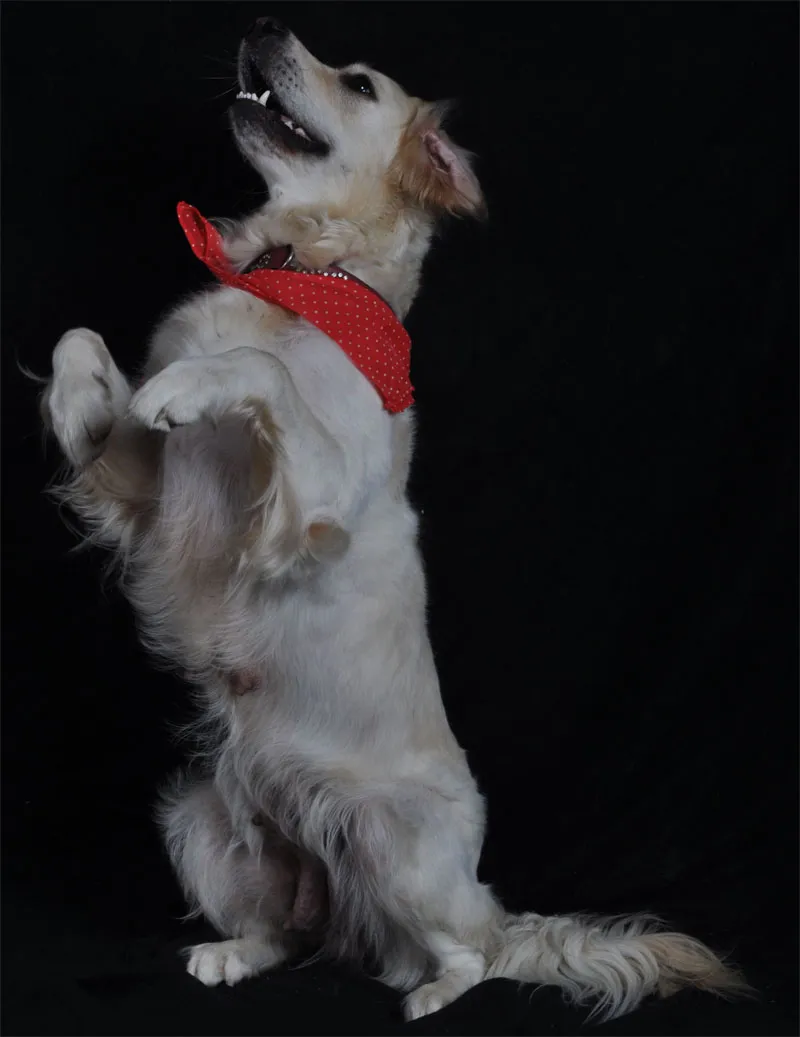
This well-trained dog was not at all interested in presenting herself to the camera, but, as you can easily see from her look, she was asking her master for new instructions, because her eyes were constantly on him! Picture is unedited (background).
8 Bello in action: the dog outdoors
Photographing dogs outdoors is a great highlight of animal photography. The photographer can never get enough of it. I eagerly await this moment. The subject, the perfect light and my camera, together in a very special place. It's simply fantastic. And if the model cooperates, the most beautiful shots are guaranteed. But how do you find this very special place, what is best suited as a background for animal photography? Bello will tell us ...
TIP: Camera settings for outdoor animals in motion: Either select aperture priority and use the widest possible aperture (e.g. 2.8) or sport mode if you prefer to use automatic camera settings. Use a sun visor for outdoor shots, and a polarizing filter is often a nice additional treat.
The right light/sun position
This point can be dealt with quickly and applies to all outdoor shoots. I am only reflecting my own experiences here, so you may well disagree with me. In the colder months, I shoot until 11:00 in the morning and then again from 15:00. This is when I have achieved the best results in terms of lighting conditions. I take photos in the summertime almost exclusively after 18:00. The light is unique then. If it is possible, I like to take photos even later, from 20:00 to 21:30. Capture the evening atmosphere in the picture and enjoy the four-legged friend in exactly this light! Of course, this does not apply to shady subjects (forest or similar), but only to shots in full sunlight. Always take photos with the sun behind you, if possible. Avoid backlit shots altogether (unless you intend to for some reason), and if there is no other way, take a slanted angle to the sun so that the light does not fall through the sun visor. I only do this in an absolute emergency.
Example: We wanted to photograph a dog swimming in a canal. When we got there, I had two options: shoot directly against the sun or walk to the other side and the dog would have been completely covered by shade, as there were tall trees there. So I chose position X and let the dog swim through the water as far to my right or left as possible. This meant that a lot of photos were destined for the trash and the light was far from ideal, but I still managed to get some usable shots.
Outdoor shoot with a concept
We usually look for different motifs for the outdoor shoot. After all, we don't just want to photograph Bello in one position with one background, we want to tease out everything he has to offer! And that's quite a lot! You can get some ideas below. But to get it right and, above all, without the dog collapsing on us, there are a few things to consider in advance. 1. plan the route you want to walk with Bello. If you are photographing in unfamiliar places, interview the owner of the animal about possible subjects and how you can best incorporate them into your shoot. The age and fitness of the dog are the main criteria for drawing up an animal-friendly plan! Ask about this if you don't already know.
Divide the shoot into different stages to avoid overexertion. After what is sure to be an exciting announcement and introduction on both sides, start your walk at a leisurely pace. Then, when the dog has calmed down, start with portrait photos, take various photos in front of a nice background in sit and down or even standing. If the dog is still rested and it is not too warm, you may be lucky and he will only pant a little or not at all for a few moments. In photos, the dog's tongue is often an unsightly accessory. Personally, it doesn't bother me, but some owners would certainly like a photo without the pink tongue. Certainly, photos with pricked ears and closed mouth in a guarded position are not the worst motif. Now you can start romping around with Bello. Go into the forest or field, throw sticks and take a photo of him. Then take a leisurely stroll to the next stop, e.g. a small forest clearing. Place Bello in a sit and down position in front of some nice backgrounds if possible and take a photo of him. Ideally, he will have recovered a little from his romp and his tongue will not be hanging out on the forest floor. Look for a small obstacle to jump over and take a few more shots. 5-6 jumps should not overtax him and should not tease the last bit out of him. If you then run a little further and have captured him again in some nice poses, you could send him into the water, assuming he likes the cool water. Always bear in mind here that your model may look a little unsightly afterwards. Wet dogs are not to everyone's taste. Especially if you want to go to the studio afterwards, there may be a long wait until the dog is dry again. I always put bathing at the very end of the shoot, and the dogs are usually dry again in the sun on the way back. We usually take a break 30-40 minutes before the studio shoot, if it can be kept to. But sometimes the four-legged friends put a spanner in the works. If you have a real water rat in your luggage, they may not wait for our GO and cool off beforehand!
Bello in the forest
It's usually dark in the forest! Clearings are ideal for photographing a dog in motion. Even with a fast lens, it can be difficult in very shady places if the dog is moving quickly. Simply place your subject in front of a tree trunk or in the fall foliage. It can look fantastic. The forest itself can also be a wonderful backdrop. Nevertheless, it always depends on your model as to how much you can and may try. Not all dogs keep still or do what they are told on command. Some situations are frightening for them or similar - always give it a try. In the colder months it looks great if you take a little of the saturation out of the forest photos, then they look more dramatic and that gives many pictures a certain flair! This is also great for two-legged photography!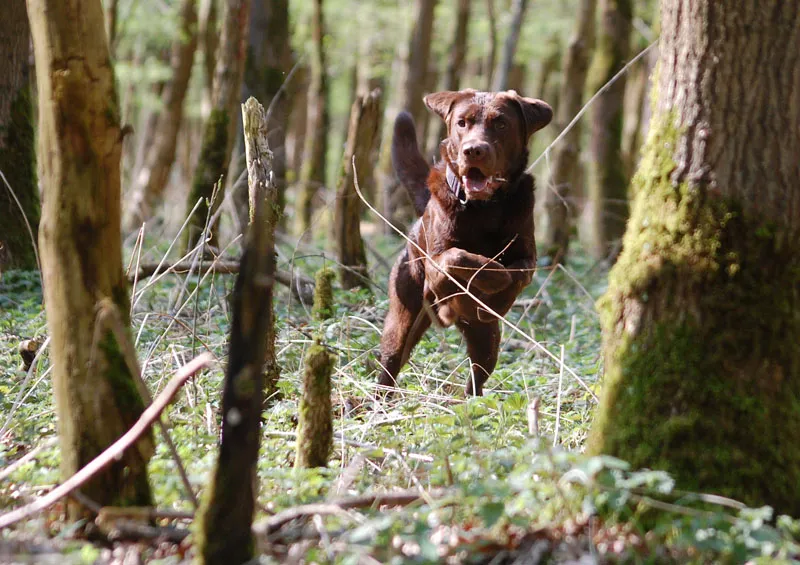
Bello jumping
If you're strolling through the woods, see if you can find a tree trunk for Bello to jump over. There are lots of things that are suitable for this. However, dogs are usually very sneaky and if the obstacle is not well demarcated, they will try to run around it somehow. Bales of straw are also always great subjects. The best way to get the dog to jump is to throw an interesting object. Dogs are usually faster on the chase than when they return with their prey. You should therefore try to place the ball or stick thrower far in front of the camera and have the object thrown in your direction towards the camera (you should check the throwing skills or the liability insurance beforehand). The dog will run much faster and also look more interesting. After all, every muscle is tensed and his eyes are focused on the target. A great motif! You will certainly need a few attempts before you can focus the dog well, even before the jump. You need to choose a position where the obstacle does not obscure the dog so that you can focus on it beforehand and take a sharp picture of it during the jump. Otherwise, simply focus on the obstacle and make sure you get the right shot. This will take a while and you should always give Bello a break between jumps. Of course, it is best if you "catch" the dog during the actual flight phase. However, you can also photograph the dog when he is only jumping with his upper body and is still pushing off the ground with his hind legs. The "landing phase" is also an interesting motif. Try it out.
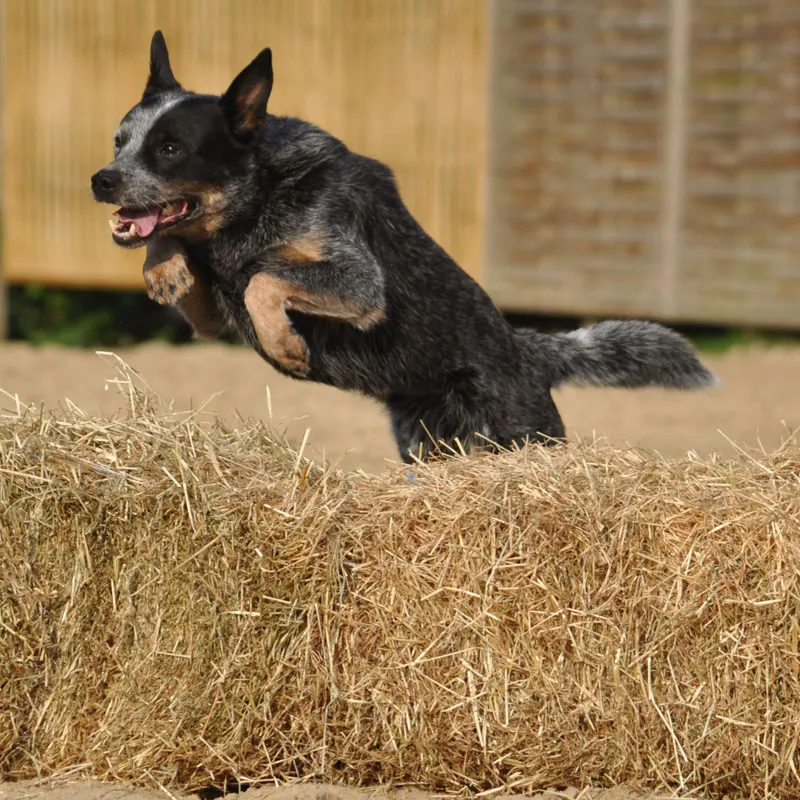
I didn't manage to get the focus right here.
Bello in the water
I'm afraid I'm going to have to come out of the closet now, because I've never been in the water with a dog to photograph it. And yet I advise you to do so! Until now, I have only photographed dogs "from above" when they were in the water. What a mortal sin. I know. So do better and go into the water with your dog ... Don't you want to? I can understand that. You can take pictures of your dog even if you're not on the same level as him. Just try to get the camera as close to the surface of the water as possible. If you have a shallow entry into the water or are even photographing by the sea, you can of course bring yourself up to a height, the ideal! However, if you have a body of water where the edge is rocky and perhaps also higher, try a few tricks. Of course you can also throw yourself into the fray in your swimming trunks, just take good care of your camera. There are also suitable clothes and trouser covers that you could use. Apart from the water splashes if you are too close to the subject, you don't have to pay too much attention here. Focus on the dog, use a large Blender (2.8 if possible) and hold it. You can encourage your model to move with a stick or a ball. In the shallow areas, of course, it all looks more spectacular than when the dog disappears completely into the water (as seen with Bello below) and only the head peeks out. The movements best suited to our shots are only possible for the dog in shallow water. It's best if he only stands with his legs in the water, with a good part of his upper body sticking out. Bello can now push himself off the surface with all his strength and jump off. The water around him will do fabulous things to the picture!
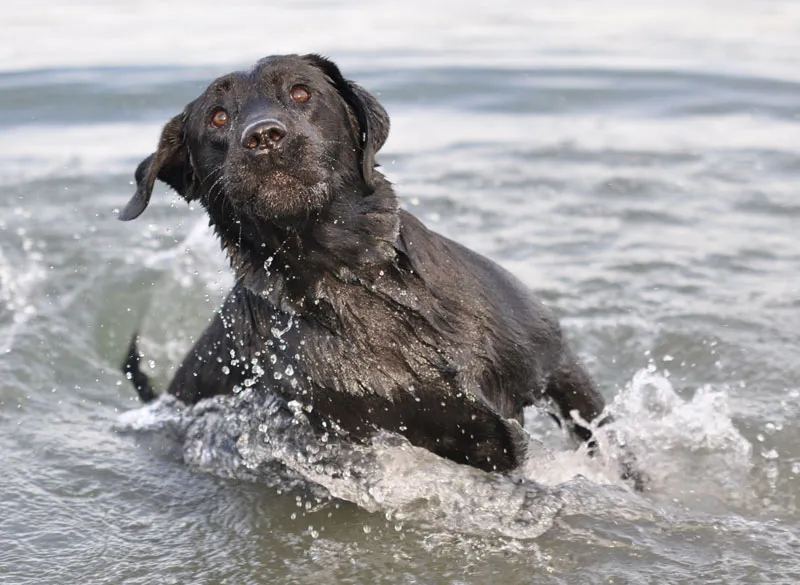
Bello running
If you take a photo of Bello running, it looks best when he is running at full speed. Just like the horse, the dog has three gaits. Walk, trot and canter (I'll leave out the pass). Both the walk and the trot, which the dog uses most for locomotion (wolf trot), are relatively boring to photograph. If the dog is moving through the landscape at a trot, it will usually be pacing a little to the right and left, poking its nose into the greenery and constantly looking out for its two-legged friend. For our photos, walking and trotting are therefore the less interesting gaits for dogs. The full gallop, on the other hand, is a sensational motif. The dog's musculoskeletal system is working at full speed and this looks incredibly great captured in the picture. As mentioned above, let the dog run in one direction again - animate it with a stick or similar and photograph it as it chases after the object. He will probably trot back to the thrower or lie down with the object or crawl into a corner. However, you need Bello to run. You can let Bello run straight or diagonally towards you or photograph him from the side. There is something to be said for both. Just make sure that the thrower is not in the picture. Choose a background that is not too conspicuous, otherwise it will distract from the subject. A stubble field in the evening sun is always beautiful! Of course, the coat color also plays a not insignificant role in the choice of background. Black dogs against a dark background are just as unfavorable as a patterned coat against restless shades of green.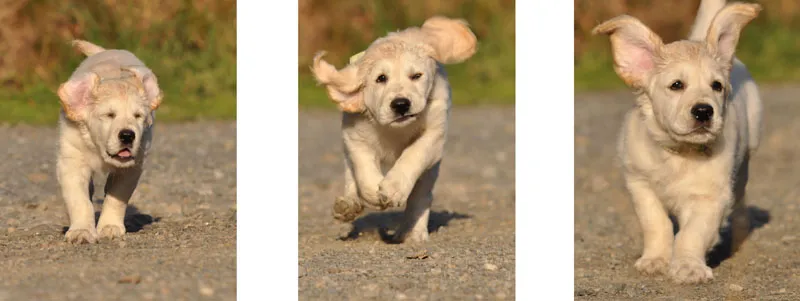
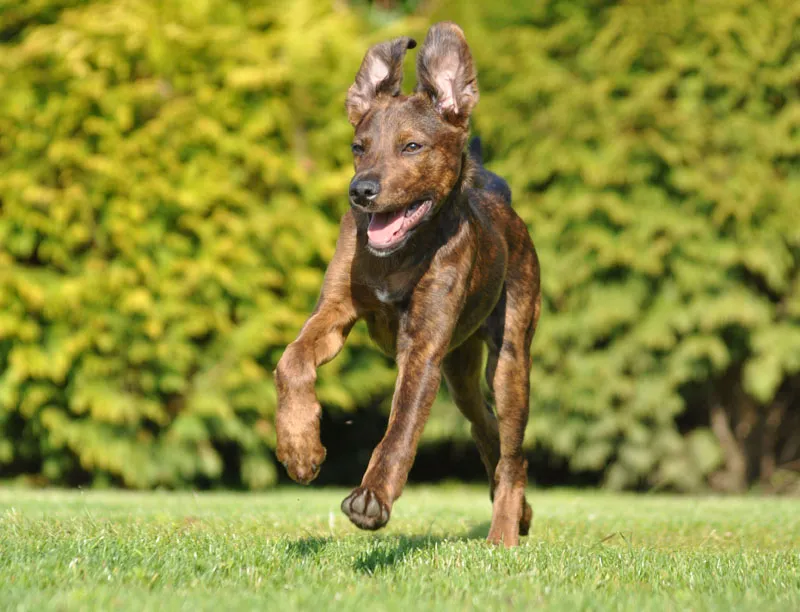
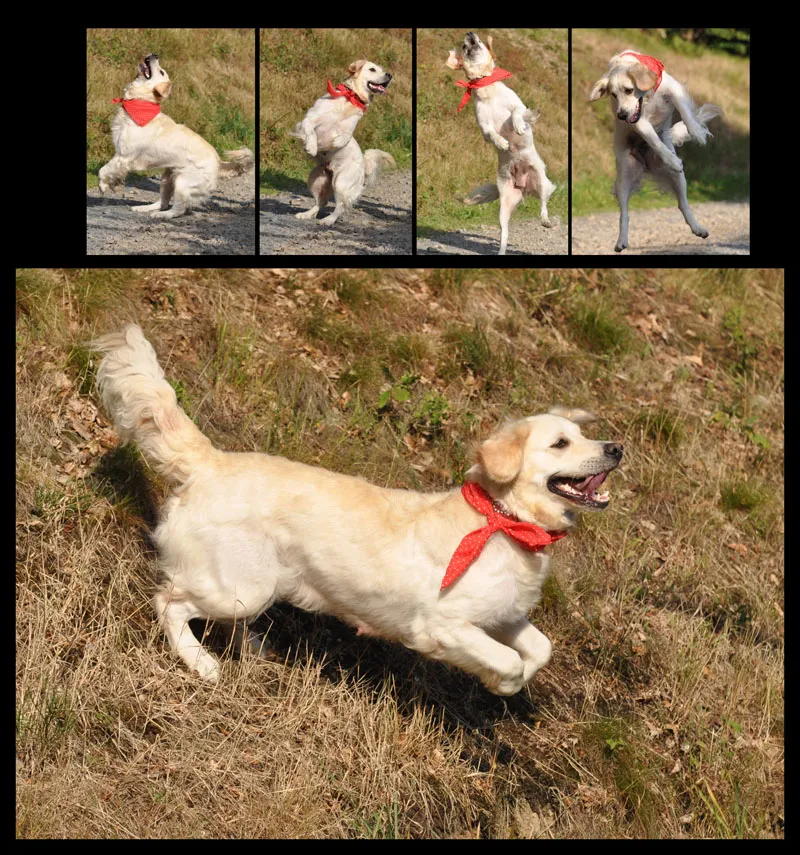
Bello at play
Two dogs playing is always a great motif. Just take a picture and see what you can use afterwards. It may seem almost impossible to capture two frolicking dogs properly, especially when their backs are turned to you, but it can still work. It just has to be the right moment, and that is when both dogs are chasing each other or breaking away from each other to jump at each other again. As nasty as this game may look at first glance, if you take the trouble to look through the viewfinder for longer, you can't help but notice how tenderly dogs can treat each other in play and how quickly they break it off when they realize that they have overdone it. Even if one of them is too tired to play, the other won't stop encouraging him until his playmate tries to catch him again. The cutest thing was the young bitch Laika (setter mix), who really put up with everything from a 15-week-old Labrador bitch. I thought her ears were about to be carried away or something similar, but she didn't do anything to the puppy. She volunteered to be the target of any attacks. If another dog "gets in my way" during a shoot, I take advantage of this and take a few play photos. Try it out!
Bringing Bello's characteristics into the picture
It's best to get a book that describes the dog breeds in detail. You should know which dogs are classified as hunting dogs and which as guard dogs. This can help you in your work by enabling you to take photos according to these characteristics. For example, if you are dealing with a genuine hunting dog, then take a photo of it doing exactly that! After all, you should portray your subject exactly as it is. With body and soul and with its entire character. I would always photograph a dog from the guard dog category (e.g. a Doberman or a Rottweiler) in the pose of the same name: Guarding! "Here I watch" should be able to be written under this photo, because this is what this dog has often been trained for. There are also other categories such as family dogs (Labradors etc.), sled dogs (huskies etc.), herding dogs or even working dogs such as rescue, police or therapy dogs. Since I, as an animal lover, also strongly condemn the prejudices against fighting dogs, I photograph these dogs in stark contrast to their unjustifiably bad reputation. If possible, I photograph them as cuddly monsters and good friends with children! Because that's exactly what a fighting dog is. I also photograph shelter dogs and most of them are fighting dogs that often have to spend many years there.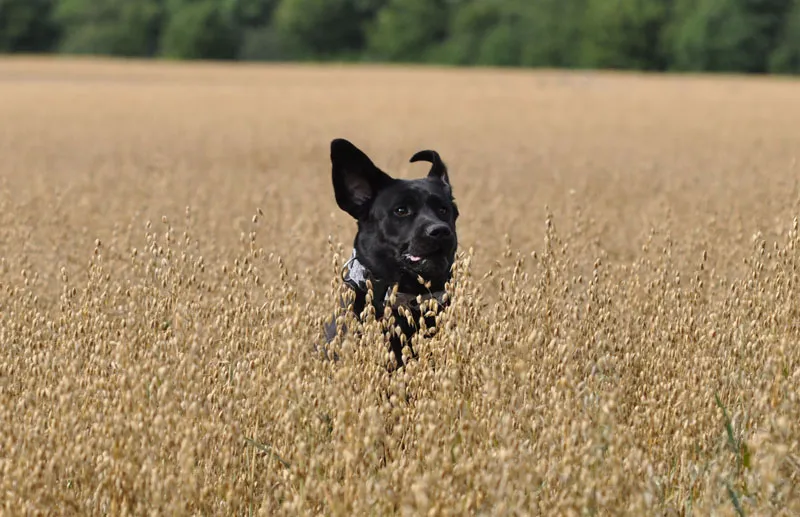
Samy likes to jump through cornfields, so here we go!
Bello's creative search
Of course, there are an incredible number of motifs that are hidden everywhere in the wild or sometimes very obvious, which we simply have to recognize as such. That's why the photographer must constantly walk through the world with open eyes. Even if it is sometimes something that has to be learned! It always happens to me that I discover such places with perfect light when nothing is within reach. Neither the camera nor a four-legged friend! Learn to see, see your surroundings through the eyes of a viewfinder. Typical and frequently used motifs are, for example
- Stones or benches that the dog can climb on or stand on with its front legs
- Bales of straw or mown fields and meadows (please ask the farmer's permission beforehand, as this is usually cattle feed!)
- Ponds or streams
- Tree trunks, mossy branches or bark
Buy some nice animal books and get some ideas for your own motif. Or rummage through a few internet image archives for free! You'll see that you'll soon develop a certain flair for it yourself when you're out on a photo shoot and recognize for yourself where Bello should be positioned for the perfect photo! Be creative, inventive and, above all, brave! What do you have to lose? Try out everything that comes to mind. You may need a well-stocked bag of treats, but otherwise it won't cost you anything except a little time.
As already described in the list of key points above: Cornfields are a great subject, even mown as a stubble field, they make an insanely great background. But you have to be careful, because the fields naturally belong to someone who takes good care of them. So it's also clear that we can't just run into the field with Bello. Once the meadows have been mown, the hay is usually left to dry for a while. So if we walk through it with Bello, we may soil the cattle feed. Since you don't want your pet to eat anything contaminated, especially as Bello might do his business in the field, we should refrain from doing so. I'll be honest, this has happened to me too, not because I didn't care, but because I just saw the motive without thinking! Fortunately, I was kindly pointed out and I've been paying attention ever since. It can also turn out differently and lead to unpleasant scenes.
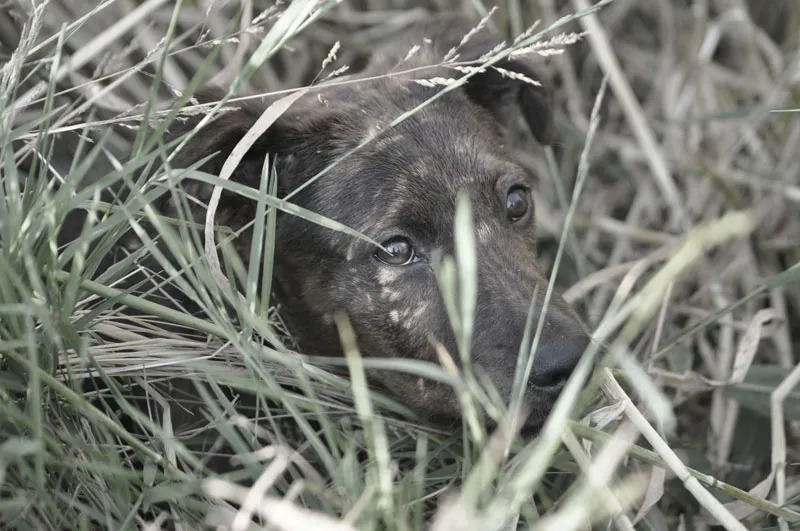
Bello at dog sports
Dog events of all kinds or simply a trip to the nearest dog park or a visit to the dog school are always an exciting spectacle for the photographer. At public events such as Dog's Day or the Dog Water Olympics, the photographer can practice undisturbed and take pictures of the dogs in action. Just have a look around dog forums or club websites, you are sure to find something in your area. However, there is no need for events, dog schools or places offer just as much action with four-legged friends. It is usually very easy to arrange such a visit. Just politely ask the owner of the dog school or dog park club. You will certainly be welcome if you promise a nice photo CD for the two-legged owners afterwards! You will be able to make contacts there very quickly, and if you say that you are looking for a model, you will certainly be able to photograph lots of great dogs. Dog schools usually have many things in their program whose names alone make the heart of every animal-loving photographer beat faster, I'm just saying puppy school, agility training, dog frisbee ...
In any case, Bello is always a real eye-catcher during sporting activities and you will certainly come home with lots of great pictures to enjoy for a long time. Don't get annoyed about incorrect cropping, blurring or wrong exposures. This is always the case and ultimately happens to every photographer. Practice makes perfect, and in the end it's enough if you've taken a few nice shots and can analyze how you can perhaps get even more out of them next time.
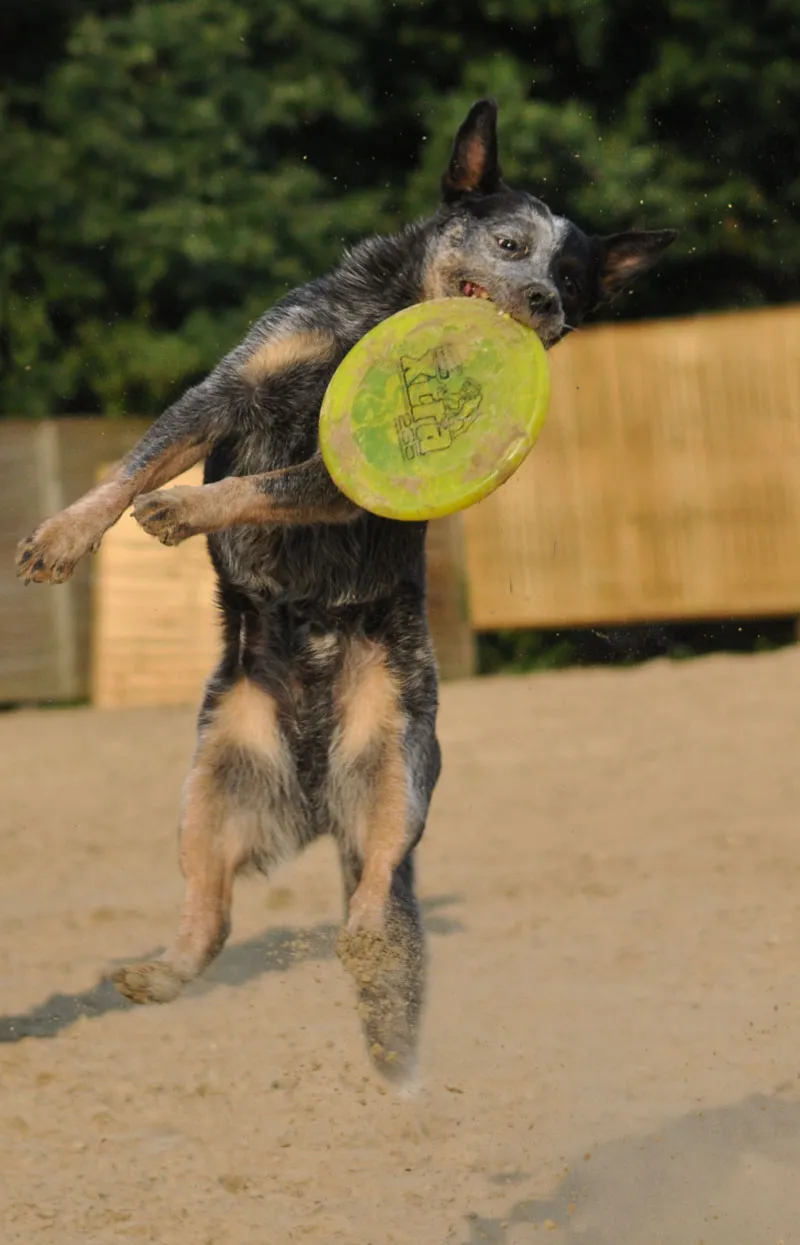
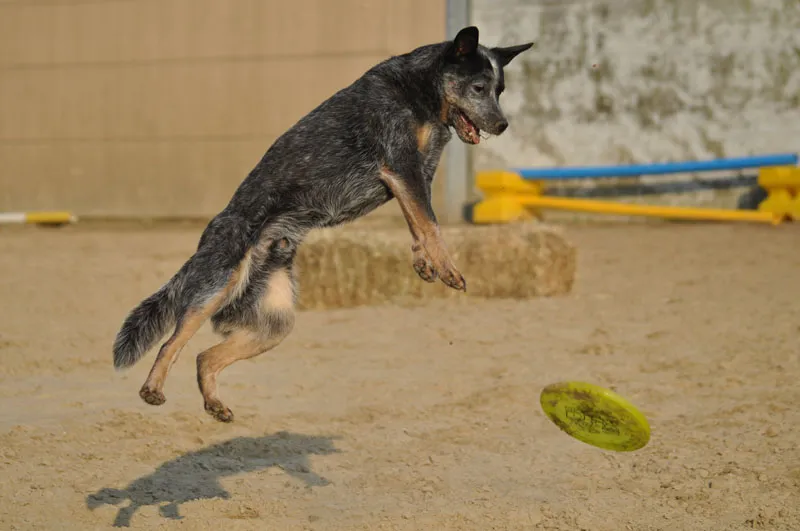
Bello in action: dogs in the studio
In the studio photography tutorial, I've already covered points such as equipment, camera settings and more. That's why I won't repeat myself here, but will focus exclusively on studio photography with dogs. So if you're also planning to take pictures of your dog in the studio, let's explain to Bello how we can make it as appealing as possible.
Instructions for the dog owner
Dogs always want to be with their pack. And they would do anything for their pack. Their eyes are therefore almost always on their two-legged "leader". As a photographer, you won't be able to do much if Bello isn't your own dog. If you are lucky, he will ignore or tolerate you, but he will never respect you! This means that your master has to do all the work. All you have to do is take photos! To do this, you should explain to the two-legged friend beforehand what he has to do so that you can take nice photos of his darling. So after introducing yourself to the dog, start with a detailed discussion about studio photography with a dog. Important points here include
- Where is the best place for the dog to position itself?
In the middle of the fabric or photo board. It should not sit too close to the back wall, too close to the edge or too close to the photographer. It should also not sit on the edges. It is best to use a background that is 1.50 m wide for small dogs and 3 m wide for large dogs. Otherwise you will constantly have the end of the background in the picture or have to keep moving. This is because your subject is not a person who can be told how to position himself. - How should the dog present itself?
This is a question that the owner should answer. Nevertheless, you should always incorporate your own ideas. In other words: Photograph the dog in as many positions as possible. In a sit, down, if possible even sideways or on its back. If he can do tricks, you can also photograph him in the manikin or pawing position. Why not include the owner in the picture? You can also take pictures of your dog standing up, but this is often difficult to achieve. - Where should the dog look?
Preferably into the camera, of course, or at least at something at the same height. If the dog is looking too far upwards, you will be photographing the dog's chin ... unattractive! If he looks too far down, it's sometimes quite cute, but you can't see his beautiful eyes. - What is the best way to animate Bello?
With every dog, you have to find out what magically captivates his eyes or makes him look intently at the camera. This is not so easy, because it must not be so interesting that Bello jumps up to grab it (certainly also a question of training), but it must be interesting enough to captivate his gaze. For some dogs this is a treat box, for others a toy, and many only react to their own master.
A "Look, yes that's fine ..." and the dog waits for its owner's command. A good time to take a photo of him, especially when he pricks up his ears and closes his mouth. Excellent! As the dog is very unlikely to react to me, I ask the owner to "sit" Bello in the middle of the studio and, if possible, persuade him to stay there with appropriate commands. The owner should then take up a position right next to me and use an object or their voice to direct the dog's gaze in my direction.
Always ask about the owner's wishes and the dog's special abilities (tricks, character traits, etc.). Incorporate these into your work. Photograph Bello as he is! With body and soul.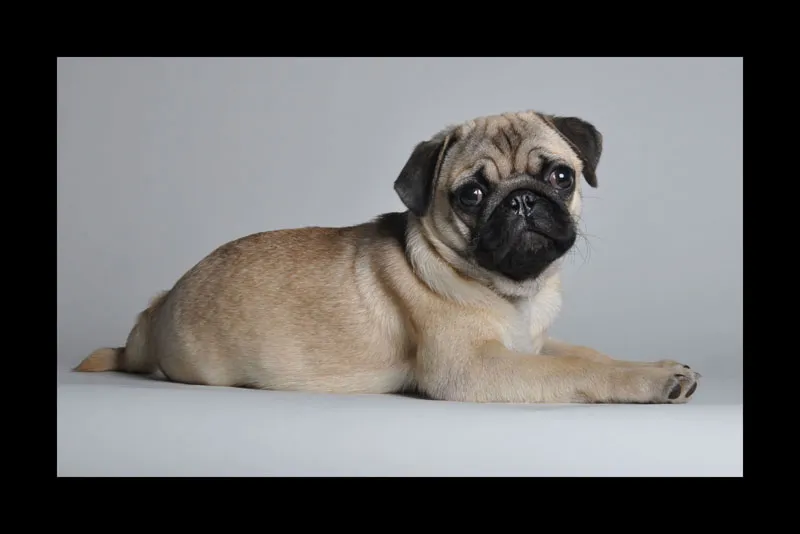
Educational level of the dog
The training of the dog is always a very relevant issue for studio photography. A lively dog that doesn't listen well to commands can easily be photographed outside when it's playing, running or just sitting there. But persuade Bello, who knows neither sit nor down, to stay still in the studio. And not just for 1 or 2 shots. We have photographed every dog, but the question is whether you will be able to take 20 pictures with difficulty or even 200 perfect photos in a quarter of the time. And even a dog that obeys commands very well can suddenly stop responding under stress and in a new environment. So you may have to pull out all the stops, and there are quite a few, and come up with all sorts of ideas to persuade Bello to take the pictures or even trick him. There is no one-size-fits-all solution here and in principle you will often be helpless, because the owner will have to persuade the dog, even if you can of course help.
Picture clippings
I am often "condemned" for only photographing parts or certain sections and details of animals. That's a matter of taste, even if the critics say it's an absolute no-go. It's always funny how many pet owners want exactly that. Please take an eye shot, please take just the face or part of the face. Just give it a try. In my opinion, it's definitely a matter of taste and pictures that always look the same are terribly boring. Of course, it is important with detail shots - just as with all studio shots - that the focus is on the dog's eyes.
In addition to detail shots, you should simply try out everything as described above and shoot the dog in as many positions as possible, including from different angles.
It would be much nicer if the dog was looking into the camera, but I found the blonde hair so interesting that I simply made this detail using Photoshop.
General information
Always have treats and toys ready. Toys should be new or cleaned. Never hold something in front of the dog's nose for too long, but always reward him for staying still after a few photos. This also increases motivation. Give him breaks and also provide fresh water.
In my experience, dogs prefer to sit on cardboard rather than fabric in warm weather. However, you have to be very careful that the cardboard doesn't slip away, which unsettles many dogs and makes it difficult to lure them back into the studio! In winter, on the other hand, fabric is a great thing.
I hope this workshop has given you some inspiration for your own outdoor or studio photographs with your dog or those of other dog owners.
See you at the next tutorial!
Nicole Schick
www.tierfotografie-mit-herz.de
